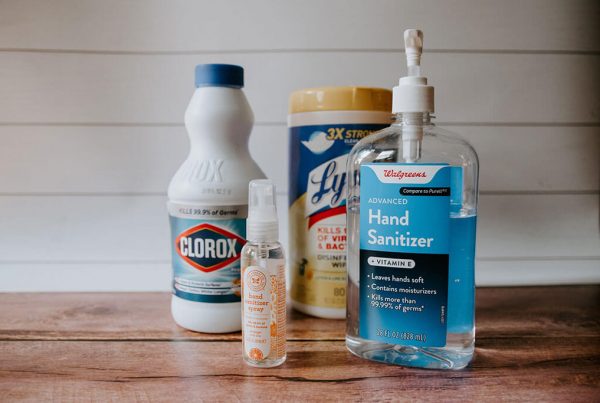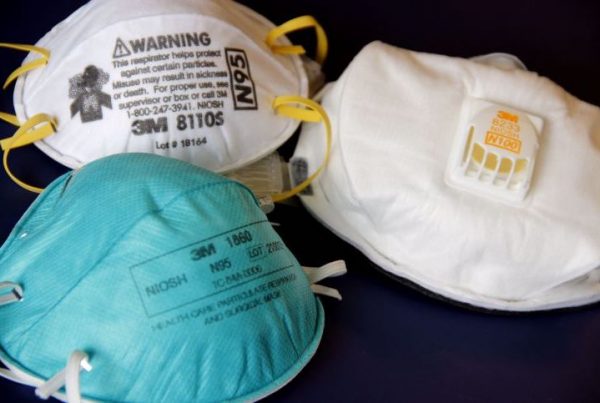WHY PROTECTIVE EYEWEAR?
Healthcare workers are highly susceptible to infections introduced through the ocular mucous membrane of the eye. Microorganisms can enter through direct contact with an infected person touching, coughing or breathing on an uninfected person’s eye. Infections can also spread through airborne particles or droplets floating or splashing into the eye. Protective eyewear is a crucial form of personal protective equipment (PPE) to avoid harmful contaminants from entering the eye region. The Center for Disease Control and Prevention (CDC) recommends the use of protective eyewear for potential exposure to viruses.
TYPES OF PROTECTIVE EYEWEAR: GOGGLES AND FACE SHIELDS
 Goggles Face Shields
Goggles Face Shields
Goggles provide a snug fit with minimal air gaps and anti-fog properties. Additionally, goggles allow healthcare workers to maintain clear peripheral vision. While they are highly effective protective eyewear, goggles only provide minimal coverage. They do not protect other parts of the face from contaminants.

Direct Ventilation Goggles Indirect Ventilation Goggles
Goggles can be directly-vented or indirectly-vented. Direct ventilation goggles contain ventilation holes on the top, bottom or sides of the goggles for constant airflow to avoid fogginess. They are more geared towards tasks involving large debris in the air (non-chemical or non-liquid). Indirect ventilation goggles do not allow outside air to enter the goggles. They contain angled vents behind the front lens which are highly effective in preventing contaminants from entering the eye. Due to the structure of the goggles, airflow into the goggles is minimal and therefore not as well ventilated as directly vented goggles. Indirect ventilation goggles are recommended to wear for infection control.
Face shields provide protection from contaminants splashing from an infected person to an uninfected person. They are designed to have a wrap-around band along the forehead or chin which ensures protection covering the face, eyes and ears.
NOTE: When working with chemical exposures, it is important to wear both goggles and a face shield together.
ARE PRESCRIPTION GLASSES OR CONTACTS FORMS OF PROTECTIVE EYEWEAR?
According to the CDC, prescription glasses or contacts are NOT forms of protective eyewear for infection control. Droplets in the air can still enter and reside on the mucous membrane of the eye and infect a person. The CDC does not recommend purchasing prescription safety glasses with side protective lenses. They do not provide adequate protection against contaminants. Instead, it is advised to wear contacts or regular prescription glasses underneath goggles or face shields.
HAND WASHING STEPS
Proper handwashing is equally important to wearing proper protective eyewear. Be sure to wash before and after inserting or adjusting contacts or prescription eyeglasses. Utilizing soap and water is the best way to avoid the spread of germs. Alcohol-based hand sanitizer (at least 60% alcohol) is an alternative form of handwashing if rubbed into skin making sure to cover all areas of the hand.
THE CDC RECOMMENDS 5 STEPS TO HAND WASHING
STEP 1: WET HANDS WITH WATER
STEP 2: TAKE SOAP AND LATHER ALL THE SURFACES OF THE HAND (BETWEEN FINGERS, UNDER NAILS AND AROUND WRISTS)
STEP 3: LATHER SOAP FOR 20 SECONDS
STEP 4: RINSE HANDS UNDER RUNNING WATER
STEP 5: DRY HANDS AND TURN OFF WATER WITH PAPER TOWEL
HOW DO I REMOVE PROTECTIVE EYEWEAR?
Avoid touching the front surface of any protective eyewear as these surfaces are critical zones of contamination. Place in an area designated for disinfecting and clean using disinfectant wipes. Make sure to wear gloves when disinfecting.
CAN PROTECTIVE EYEWEAR BE REUSED?
Protective eyewear can be reused after disinfected with proper disinfectant wipes or sprays. Wear gloves when disinfecting the eyewear to prevent cross-contamination.
HOW DO I SELECT THE RIGHT PROTECTIVE EYEWEAR FOR ME?
THE CDC RECOMMENDS:
- FIT
- EXPOSURE
- PROCEDURE
WHERE SHOULD HEALTHCARE PROFESSIONALS WEAR PROTECTIVE GARMENTS?
- HOSPITALS
- HOME HEALTH AIDE AGENCIES
- HOSPICES
- LONG-TERM CARE FACILITIES
- FIRST RESPONDERS
- NURSING HOMES
- PRIVATE HEALTHCARE CLINICS
Citations:
https://www.albanycountyfasteners.com/blog/2018/11/05/indirect-vs-direct-ventilation-safety-goggles/
https://www.cdc.gov/handwashing/when-how-handwashing.html
https://www.cdc.gov/niosh/topics/eye/eye-infectious.html
https://www.cdc.gov/hai/pdfs/ppe/PPEslides6-29-04.pdf
https://www.usatoday.com/story/news/nation/2014/10/20/cdc-new-protocol/17638161/
Zayba Syed is a graduate of Virginia Polytechnic Institute and State University working to pursue a Masters of Public Health-Physician Assistant (MPH-PA) dual degree.




